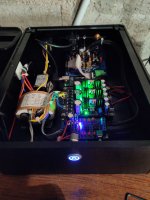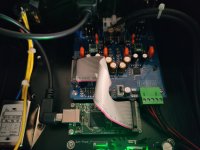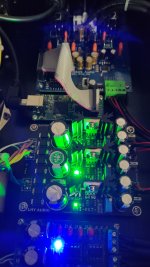Is there a perceptible difference?It is not about the perceived noise, but about better jitter performance.
Doesn't the USB to I2S module you linked above contain its own clock? I don't really want to get into hats and would like to stick to USB interface.An expansion card for Pi with reclocking can help matters.
I haven't tried yet, But others claim it does.Is there a perceptible difference?
Yes, the board has its own clocks. I agree that reclocking at Pi doesn't make sense. USB asychron solution using this board is better,Doesn't the USB to I2S module you linked above contain its own clock?
You could even better these clocks by replacing with better ones. But if it really improves things further? Some claim it is noticeable.
But first thing for improvement (when urged) is indeed to use a clean supply for the board. So the clocks on the board can work optimal.
Yeah, I also doubt that the jitter is something I need to worry at this stage. I do intend to power USB board with its own power supply, so this will get me 95% of the way. I'm only slightly concerned about the quality of these random Chinese boards, but in the end they are not very expensive and it will be a good learning experience to assemble a DAC for the first time.
I'm only slightly concerned about the quality of these random Chinese boards, but in the end they are not very expensive and it will be a good learning experience to assemble a DAC for the first time.
If it helps you...
The least interesting part of DIY is the machining of the case...to integrate the DAC outputs with the rear panel.
I realized that the DAC card is available without the output connectors... That would have been simpler.
Attachments
Thanks for the tip, for me it would also be way easier to connect the outputs by wires to the ports on the rear panel.I realized that the DAC card is available without the output connectors... That would have been simpler.
Btw, Do you have any idea why this USB interface is more expensive than the one you linked?
Thanks for the tip, for me it would also be way easier to connect the outputs by wires to the ports on the rear panel.
Btw, Do you have any idea why this USB interface is more expensive than the one you linked?
Seen on Ebay, but sold without op amp...
It is therefore necessary to add 2 double op amps and 2 singles...
Anyway...I don't know if it's worth it.
Does anyone have a feeling how these MA5332 boards compare to older UCD amps?
Or indeed the low powered nCores (there are some modules for sale locally on eBay).
I have a Rotel RKB-8100 (actually a D8100) but its a bit physically noisy. It claims 8*100w but I don't need that really, I'm just looking for something I can use to play with multiway speakers.
I'm ondering whether I should just repurpose the chassis (and maybe the phono socket buffer board if I can) and replace the amps and power supply, hopefully removing the fans.
Or indeed the low powered nCores (there are some modules for sale locally on eBay).
I have a Rotel RKB-8100 (actually a D8100) but its a bit physically noisy. It claims 8*100w but I don't need that really, I'm just looking for something I can use to play with multiway speakers.
I'm ondering whether I should just repurpose the chassis (and maybe the phono socket buffer board if I can) and replace the amps and power supply, hopefully removing the fans.
@jmansion Well, MA5332 is pre-filter feedback and UcD is post-filter. UcD wins in that regard. Neither have super impressive distortion figures (talking about the cheap UcD stuff, not the high end). Haven't listened to either though, so no idea how they sound.
Anyway, you sent me down a rabbit hole on ebay and now I have a used Sonance DSP 8-130 on the way to me. It was $100 and contains 8x UcD250LP, so I couldn't pass it up, even though I have no need for it. Guess it will give me something to play around with over the winter.
Anyway, you sent me down a rabbit hole on ebay and now I have a used Sonance DSP 8-130 on the way to me. It was $100 and contains 8x UcD250LP, so I couldn't pass it up, even though I have no need for it. Guess it will give me something to play around with over the winter.
Yes, it was listed "for parts". Seller claims they couldn't test the unit because the input cards are missing.
In this read I see a couple of distortion graphs.
I would like to highlight some extremely important regarding those.
Without knowing the type of feedback loop as well as the type of inductors being used (and to a small extend the dead-time), this is comparing apples with bananas.
Compared to like Class-AB amplifiers, these three components are far more important in Class-D designs than the type of switching element that is being used.
In other words, you can't just simply show a graph with "better" numbers and therefor conclude certain things immediately.
There are many other variables (like the three I mentioned) that have just an impact that is far to significant.
So these graphs don't show much unfortunately.
It's like showing the performance of two completely different cars and claiming that the tires are better.
Way to long I2s cable.If it helps you...
The least interesting part of DIY is the machining of the case...to integrate the DAC outputs with the rear panel.
I realized that the DAC card is available without the output connectors... That would have been simpler.
Attachments
Way to long I2s cable.
It's okay, 13 cm....Originally it was an IDE hard drive ribbon cable.
The ribbon cable delivered with this optional card is 10 cm.
No interference, nothing....Even when touching the ribbon cable with your fingers.😊
I replaced the double JRCs, as you guessed it with opa1656, the single JRCs for the rca remained in place.you cannot replace them with opa1656, try opa1655 or something else!
I like this card! It outperforms my smsl M300 ak 4497 dac....
Last edited:
In this read I see a couple of distortion graphs.
I would like to highlight some extremely important regarding those.
Without knowing the type of feedback loop as well as the type of inductors being used (and to a small extend the dead-time), this is comparing apples with bananas.
Compared to like Class-AB amplifiers, these three components are far more important in Class-D designs than the type of switching element that is being used.
In other words, you can't just simply show a graph with "better" numbers and therefor conclude certain things immediately.
There are many other variables (like the three I mentioned) that have just an impact that is far to significant.
So these graphs don't show much unfortunately.
It's like showing the performance of two completely different cars and claiming that the tires are better.
It was only for information...So...Everyone deduces what they want...
There are not only donkeys on this forum...Mr. Skeptical... 😉
I am fully aware, that's why I just wanted to highlight it 🙂It was only for information...So...Everyone deduces what they want...
There are not only donkeys on this forum...Mr. Skeptical... 😉
We should open a separate thread for this device. I got a second one transformer coupled to MA12070 amp without any active element either on the dac or on the amp. Absolute pristine sound.It's okay, 13 cm....Originally it was an IDE hard drive ribbon cable.
The ribbon cable delivered with this optional card is 10 cm.
No interference, nothing....Even when touching the ribbon cable with your fingers.😊
I replaced the double JRCs, as you guessed it with opa1656, the single JRCs for the rca remained in place.you cannot replace them with opa1656, try opa1655 or something else!
I like this card! It outperforms my smsl M300 ak 4497 dac....
That's a lot less than I paid for the Rotel - which also has 8-off UcD250LP.@jmansion Well, MA5332 is pre-filter feedback and UcD is post-filter. UcD wins in that regard. Neither have super impressive distortion figures (talking about the cheap UcD stuff, not the high end). Haven't listened to either though, so no idea how they sound.
Anyway, you sent me down a rabbit hole on ebay and now I have a used Sonance DSP 8-130 on the way to me. It was $100 and contains 8x UcD250LP, so I couldn't pass it up, even though I have no need for it. Guess it will give me something to play around with over the winter.
Oh, I didn't know that about the Rotel. Are you not happy with the sound of the UcD modules or is it simply a matter of the fans being noisy?
Received the amp and it's in excellent physical condition. It looks like it was serviced at one point and some of the modules possibly replaced. I snagged an analog input module for $15 that will be here in a few days so I can test it. It's too bad the DSP in it is so basic.
Received the amp and it's in excellent physical condition. It looks like it was serviced at one point and some of the modules possibly replaced. I snagged an analog input module for $15 that will be here in a few days so I can test it. It's too bad the DSP in it is so basic.
I finally changed the MA5532 card for the coupling caps and opamp.
Used the AudioNote caps I had lying around and changed the opamp to 1656.
It is a completely different beast now. In blind testing you won't think it is the same board.
Gone is the strange coloration and some roughness. It sounds as a very well conventional amp now. Quiet 'high endisch' I would say.
Very well behaving, controlled, nice crisp, clean sound, absolutely quiet. (used the feedback modified board). Just good.
But also also gone is the incredible sensed dynamic (power), the open, high, wide and deep soundstage, the transparency, the live kind of sound. The magic that made me want to listen more and more. Highs and Lows are limited in comparison. It lacks the dynamics now, no real punch., although it gives some hints that it could go much faster.
In comparison it sounds thick and slow, holding back, modest. (Keep in mind, in comparison.)
The analogy that came to mind to me is the comparison between between good conventional loudspeakers and good horn speakers.
The horns sounding detailed, clean, open, dynamically but with the according coloration.
Getting both positive aspects of the 2 versions would make this a winner.
Again it is not the 5332 that determines the perceived sound quality, but the circuit before it. (as with the MA12070 in he Sabaj).
Al least we know now: It won't hold anything back in dynamics and openness but also is able to sound very clean and crisp.
Used the AudioNote caps I had lying around and changed the opamp to 1656.
It is a completely different beast now. In blind testing you won't think it is the same board.
Gone is the strange coloration and some roughness. It sounds as a very well conventional amp now. Quiet 'high endisch' I would say.
Very well behaving, controlled, nice crisp, clean sound, absolutely quiet. (used the feedback modified board). Just good.
But also also gone is the incredible sensed dynamic (power), the open, high, wide and deep soundstage, the transparency, the live kind of sound. The magic that made me want to listen more and more. Highs and Lows are limited in comparison. It lacks the dynamics now, no real punch., although it gives some hints that it could go much faster.
In comparison it sounds thick and slow, holding back, modest. (Keep in mind, in comparison.)
The analogy that came to mind to me is the comparison between between good conventional loudspeakers and good horn speakers.
The horns sounding detailed, clean, open, dynamically but with the according coloration.
Getting both positive aspects of the 2 versions would make this a winner.
Again it is not the 5332 that determines the perceived sound quality, but the circuit before it. (as with the MA12070 in he Sabaj).
Al least we know now: It won't hold anything back in dynamics and openness but also is able to sound very clean and crisp.
- Home
- Amplifiers
- Class D
- MA5332



